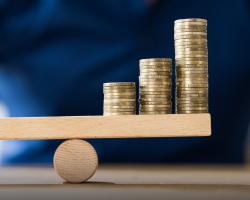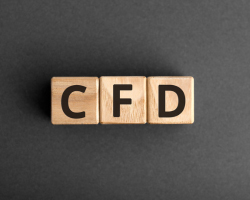Leveraging Gains: Navigating the Dynamics of Leverage, Buyouts, and Tokens in Finance

Leverage, a fundamental concept in trading and investment, has the potential to significantly amplify returns but also comes with inherent risks. This financial tool involves the strategic use of borrowed capital to enhance trading capacity, with the expectation of increased earnings during favorable market conditions. Brokers and exchanges commonly facilitate leverage, while traders may supplement it with funds from alternative sources. Distinguishing leverage from the margin is essential, as they are interconnected yet distinct concepts. Margin, the requisite amount to sustain leverage, introduces the daunting prospect of margin calls, demanding additional funds to uphold a trade. Understanding leverage mechanics is crucial, illustrated by a practical example showcasing how it can magnify returns in day trading and financial market investments. Brokers offer leverage in specific ratios, emphasizing its role in boosting trading capacity.
When used well, leverage can help you boost your gains in all types of assets, including stocks, currencies, and commodities. This article will explain how leverage works and assess its risks and benefits.
Definition of Leverage
Leverage is the utilization of borrowed capital in trading and investment activities. The fundamental concept involves employing borrowed funds with the expectation that they will enhance lucrativeness when market conditions align favorably.
In most instances, brokers and exchanges facilitate the provision of leverage. Additionally, traders may augment their leverage by obtaining funds from alternative sources.
Distinguishing Leverage from Margin
The concept of leverage is closely linked to that of margin. As previously mentioned, leverage represents a loan that magnifies a trader's trading capacity.
Conversely, margin refers to the requisite amount of capital in a trader's account to sustain their leverage. On one hand, margin signifies the funds needed to initiate a position, while leverage denotes the multiplier effect enabling borrowing.
A margin call is a daunting occurrence in the financial realm. It transpires when the lender demands additional funds to uphold a trade. Failure to inject these funds results in the termination of the loss-incurred trade, leading to substantial financial losses.

Understanding Leverage Mechanics
To comprehend how leverage operates, consider the following example:
Imagine you have $10,000 for investment and identify a stock priced at $10. Without leverage, you could purchase 1,000 shares. If the stock rises to $15, your yield (excluding trading costs) would be $5,000 [(15×1000) – (1,000 x 10)].
Now, suppose you're highly confident the stock will reach $15 and decide to borrow an additional $10,000 for investment. With a total capital of $20,000, you can now acquire 2,000 shares. If the stock reaches $15, your total capital becomes $30,000. Repaying the $10,000 borrowed results in a net of $20,000.
This example illustrates how leverage can amplify returns in day trading and financial market investments.
Brokers typically provide leverage in the form of ratios, such as 1:100, 1:200, or 1:50. These ratios indicate the extent to which one can borrow funds for trading. For instance, a 1:100 ratio implies that with $2,000, a trader can operate as if they have $200,000.
What Is a Leveraged Buyout (LBO)
In the realm of high finance, a significant concept is the leveraged buyout (LBO). This occurs when a company or individual employs a substantial amount of debt to finance an acquisition. Frequently, this debt is secured by the assets of the company being acquired.
An illustrative example of an LBO is Elon Musk's acquisition of Twitter for $44 billion. Musk utilized a combination of personal funds and collaborations with associates to finance the acquisition. The remaining portion of the transaction was funded through loans, which were secured by Twitter's assets.
Following the acquisition, Musk directed the revenues generated by Twitter to settle the incurred debts. This exemplifies a common approach in leveraged buyouts, where the acquired company's own financial strength is used to repay the debt incurred during the acquisition.
Prominent instances of leveraged buyouts include transactions involving companies like PetSmart, RJR Nabisco, and Hilton Hotels, underscoring the prevalence of this financial strategy in the corporate landscape.

What Are Leveraged Tokens?
Leveraged tokens are a financial instrument designed for cryptocurrency trading that allows investors to gain leveraged exposure to the price movements of a specific cryptocurrency or digital asset. These tokens are typically issued by cryptocurrency exchanges or financial platforms and are structured to provide amplified returns based on the performance of an underlying asset.
Here are the key characteristics and features of leveraged tokens:
Leverage Multiplier
Leveraged tokens aim to provide a multiple of the daily returns of the underlying asset they track. Common leverage factors include 2x, 3x, or more. For example, a 3x leveraged token may seek to achieve three times the daily returns of the corresponding cryptocurrency.
Short and Long Positions
Leveraged tokens are available for both long (betting on price increases) and short (betting on price decreases) positions. Long leveraged tokens aim to multiply gains on rising prices, while short leveraged tokens seek to multiply gains on falling prices.
Daily Reset
Most leveraged tokens are designed to reset their leverage on a daily basis. This means that their performance is calculated and reset each day, making them suitable for short-term trading strategies. However, due to the daily reset, the long-term performance of these tokens may deviate from the expected multiple of the underlying asset's returns.
Risk of Decay
The daily reset mechanism introduces the risk of compounding and decay over time. This means that the leveraged token's performance over a period longer than one day may not precisely correspond to the multiple of the underlying asset's cumulative returns.
Volatility Impact
Given their leveraged nature, these tokens can be highly sensitive to short-term price movements and market volatility. Sudden and significant price changes in the underlying asset can result in amplified gains or losses for investors.
It's important for investors to thoroughly understand the mechanics and risks associated with leveraged tokens before incorporating them into their trading strategies. Due to their complexity and the potential for rapid value changes, leveraged tokens are often considered more suitable for experienced and risk-tolerant traders. As with any financial instrument, careful consideration and risk management are crucial when dealing with leveraged tokens.
Effectively Using Leverage for Maximum Gains
To optimize your returns through leverage, consider the following strategies:
- Start Small
Initiate your trading journey with a conservative leverage ratio. A prudent approach is to commence with a ratio of 1:2. Although this might limit potential returns initially, it allows for a gradual mastery of the trading process. As experience grows, you can incrementally increase your leverage. - Craft a Solid Trading Strategy
Develop a well-tested and reliable trading strategy. The efficacy of this strategy is paramount in minimizing the risk of significant losses. A robust plan provides a foundation for informed decision-making and enhances the likelihood of successful trades. - Implement Stop Loss Orders
Always incorporate Stop Loss orders in your trades. A Stop Loss functions as an automatic mechanism, halting a trade when it reaches a predetermined level of loss. This tool serves to restrict the maximum potential loss, acting as a safeguard against substantial negative outcomes.

Benefits of Leverage in Trading
Leverage stands as a pivotal concept in the realms of trading and investment, offering notable advantages:
- Increased Asset Acquisition
The primary benefit of leverage lies in its capacity to enable traders to acquire more assets than the funds available in their accounts. While this approach limits risks, as illustrated in the earlier example, it can lead to significant earnings. - Facilitates Undervalued Asset Purchase
In a broader financial context, leverage simplifies the process of purchasing undervalued assets and subsequently enhancing their worth. A notable example is Blackstone's lucrative exit from its highly leveraged investment in Hilton, showcasing how strategic leveraging can result in substantial financial gains.
Cons of Leverage in Trading
While leverage stands as a powerful tool in trading and investments, its utilization comes with inherent risks that demand careful consideration. Here are the key cons associated with leverage:
- Amplified Losses
One of the most significant drawbacks of leverage is its potential to magnify losses. While it enhances yield potential, it equally exacerbates the impact of market downturns. Traders can find themselves in precarious situations where losses exceed their initial investment. - Margin Calls
Leverage often necessitates maintaining a certain level of margin in the trading account. In volatile market conditions, adverse price movements can trigger margin calls, requiring traders to inject additional funds into their accounts. Failure to meet margin calls can result in forced liquidation of positions and substantial losses. - Interest Costs
Borrowing funds through leverage incurs interest costs. These costs can accumulate, eating into returns or exacerbating losses. Traders must factor in these interest expenses when assessing the overall income potential of leveraged positions. - Limited Room for Error
With leverage, the margin for error diminishes significantly. Small market fluctuations can have outsized impacts on leveraged positions, making it crucial for traders to have precise market timing and risk management strategies. - Overtrading Risks
The availability of leverage might tempt traders to overtrade, engaging in a high volume of transactions without a solid strategy. Overtrading can lead to increased transaction costs and heightened exposure to market volatility. - Market Volatility Impact
Leverage is particularly sensitive to market volatility. In turbulent market conditions, the risk of significant price swings is heightened, potentially leading to rapid and substantial losses for leveraged positions. - Psychological Stress
The psychological toll of managing leveraged positions can be substantial. The emotional strain associated with amplified gains and losses can cloud judgment and contribute to impulsive decision-making, further exacerbating risks.
In navigating the complexities of leverage, traders and investors must weigh the potential rewards against these inherent risks. A meticulous understanding of one's risk tolerance, coupled with disciplined risk management practices, is crucial in mitigating the cons associated with leverage and safeguarding against unforeseen market challenges.
Conclusion
In conclusion, while leverage is a powerful tool that can significantly enhance return, its judicious use is imperative. Traders and investors must weigh the potential rewards against the inherent risks associated with leverage. A comprehensive understanding of leverage mechanics, coupled with disciplined risk management practices, is crucial for navigating the complexities of the financial landscape. As the article demystifies leverage, leveraged buyouts, and leveraged tokens, it equips readers with the knowledge to make informed decisions and harness the potential of leverage while mitigating its associated cons. In the dynamic world of finance, leveraging wisely becomes the key to unlocking opportunities and managing risks effectively.
About AdroFx
Established in 2018, AdroFx is known for its high technology and its ability to deliver high-quality brokerage services in more than 200 countries around the world. AdroFx makes every effort to keep its customers satisfied and to meet all the trading needs of any trader. With the five types of trading accounts, we have all it takes to fit any traders` needs and styles. The company provides access to 115+ trading instruments, including currencies, metals, stocks, and cryptocurrencies, which make it possible to make the most out of trading on the financial markets. Considering all the above, AdroFx is the perfect variant for anyone who doesn't settle for less than the best.










